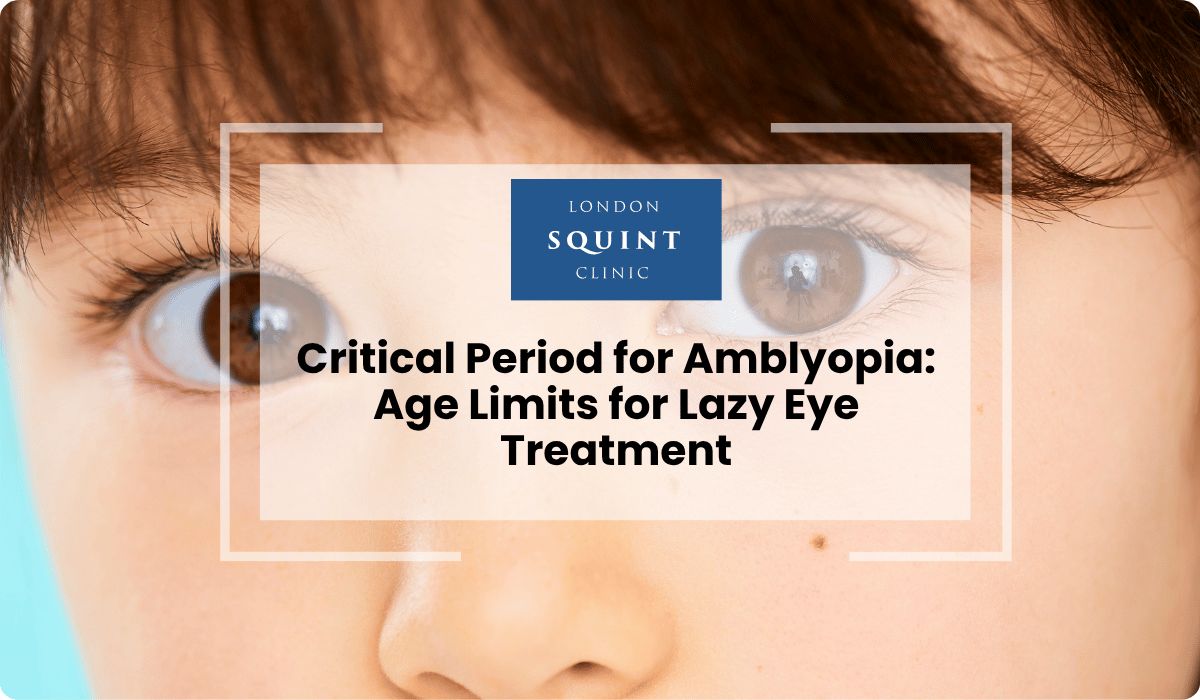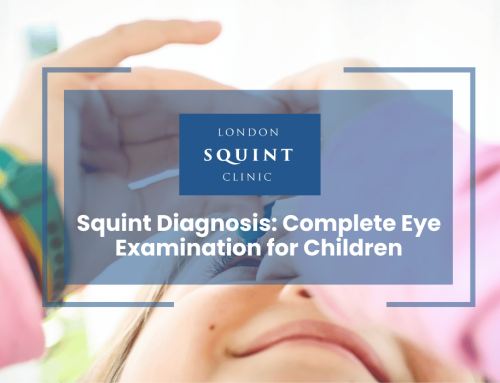Critical Period for Amblyopia: Age Limits for Lazy Eye Treatment
Essential Insights: Age and Amblyopia Treatment
- Early detection is critical – Treatment before age 3 has success rates exceeding 90%, while effectiveness gradually decreases with age
- The critical period isn’t absolute – While visual development is most plastic from birth to age 7, some neuroplasticity persists into adolescence and adulthood
- Age-appropriate approaches matter – Treatment strategies should evolve from simple patching in toddlers to more engaging binocular therapies for older children
- Adults can still benefit – Newer research shows meaningful improvements are possible beyond childhood through perceptual learning, binocular training, and neuromodulation
- Regular screening is essential – Many children show no obvious external signs of amblyopia, making professional vision assessments crucial for early detection
Table of Contents
- Understanding Amblyopia: The Science Behind Lazy Eye
- What Is the Critical Period for Amblyopia Development?
- Early Intervention: Why Timing Matters for Treatment Success
- Age-Specific Treatment Approaches for Amblyopia
- Breaking the Age Barrier: New Research on Adult Treatment
- Recognizing Amblyopia Signs Across Different Age Groups
- Beyond the Critical Period: Alternative Therapies for Older Patients
Understanding Amblyopia: The Science Behind Lazy Eye
Amblyopia, commonly known as lazy eye, is a neurodevelopmental condition affecting approximately 3% of children worldwide. Unlike many eye conditions, amblyopia is not primarily an anatomical problem with the eye itself but rather a developmental issue in the visual processing system of the brain. When a child’s brain receives unequal or poor-quality visual input from one eye during early development, it begins to favour the stronger eye and suppresses input from the weaker one.
This suppression occurs because the brain is attempting to avoid visual confusion or double vision (diplopia). Over time, without proper intervention, the neural pathways that process information from the affected eye fail to develop properly. The result is reduced visual acuity that cannot be immediately corrected with glasses or contact lenses.
The underlying neurological mechanism involves changes in the visual cortex, where binocular vision development is disrupted. Normally, neurons in the visual cortex receive input from both eyes, but in amblyopia, there is a shift towards dominance by the stronger eye. This neuroplasticity—the brain’s ability to reorganise itself—works against visual development in amblyopia but can also be leveraged for treatment during the critical period of visual development.
What Is the Critical Period for Amblyopia Development?
The critical period for amblyopia refers to the developmental window during which the visual system is most susceptible to abnormal visual experiences and, importantly, most responsive to treatment. This sensitive period for vision development begins shortly after birth and extends through early childhood, with varying degrees of plasticity.
Research indicates that the most crucial phase occurs during the first 3-5 years of life, when the visual cortex exhibits maximum neuroplasticity. During this time, visual experiences shape the architecture of neural connections in the brain. If one eye provides blurred or misaligned images, the brain begins to favour the eye providing clearer input, leading to amblyopia development.
The critical period can be divided into distinct phases:
- Peak sensitivity (birth to 3 years): When the visual system is most vulnerable to developing amblyopia and simultaneously most responsive to treatment
- Declining sensitivity (3 to 7 years): Treatment remains effective but may require more intensive approaches
- Extended sensitivity (7 to 12 years): Some degree of plasticity remains, allowing for treatment with variable success rates
Understanding these windows of visual development is essential for timing interventions appropriately. While traditional teaching suggested that treatment beyond age 7-9 years was largely ineffective, contemporary research has challenged this rigid cutoff, revealing that some degree of neuroplasticity persists beyond these previously established age limits.
Early Intervention: Why Timing Matters for Treatment Success
Early intervention for amblyopia capitalises on the brain’s heightened neuroplasticity during the critical period, significantly improving treatment outcomes. Research consistently demonstrates that the earlier amblyopia is detected and treated, the greater the likelihood of complete visual recovery. This time-sensitive approach is fundamental to preventing permanent visual impairment.
When treatment begins before age 3, success rates can exceed 90%, with many children achieving normal or near-normal vision. Between ages 3-5, success rates remain good but may require longer treatment duration. By ages 6-7, while improvement is still possible, complete resolution becomes less likely, with approximately 60-75% of children responding adequately to standard therapies.
The compelling evidence for early intervention has led to the implementation of universal vision screening programmes in many countries. In the UK, the National Screening Committee recommends vision screening for all children aged 4-5 years. However, earlier screening during routine health visits can identify children at risk even sooner.
Early treatment not only improves visual outcomes but also prevents secondary complications including:
- Impaired depth perception and stereopsis
- Reduced visual-motor coordination
- Educational challenges related to visual processing
- Increased risk of vision loss in the better eye later in life
Parents should be aware that amblyopia rarely improves without treatment, and delaying intervention only reduces the chances of complete recovery. This underscores the importance of regular paediatric vision assessments, particularly for children with risk factors such as family history of eye conditions, premature birth, or developmental delays.
Age-Specific Treatment Approaches for Amblyopia
Treatment strategies for amblyopia must be tailored to the child’s age, considering both neuroplasticity factors and practical compliance issues. The approach evolves as children mature, balancing biological effectiveness with age-appropriate interventions.
Infants and Toddlers (0-3 years)
For the youngest patients, addressing underlying causes is paramount. This may include early prescription of glasses for refractive errors, cataract removal, or squint surgery to align the eyes. Patching therapy in this age group typically begins with shorter durations (2-3 hours daily) to prevent disruption to binocular vision development. Close monitoring is essential, with assessments every 6-8 weeks to adjust treatment intensity.
Preschool Children (3-5 years)
This age group often responds well to traditional amblyopia treatments. Patching regimens may increase to 4-6 hours daily for moderate amblyopia, while atropine penalisation (using eye drops to blur vision in the stronger eye) becomes a viable alternative for children who resist patching. Vision therapy exercises can complement these approaches, enhancing binocular function.
School-Age Children (6-12 years)
As children enter school, treatment compliance often becomes challenging. More intensive approaches may be necessary, including longer patching hours for severe amblyopia. Combination therapies gain importance, with near activities during patching enhancing effectiveness. Digital therapies using tablet-based games that train binocular vision show promising results for this age group, improving engagement and compliance.
Adolescents (12+ years)
While traditionally considered beyond the optimal treatment window, newer research suggests that motivated adolescents can still benefit from modified approaches. Intensive perceptual learning programmes, contrast-balanced binocular treatments, and video game-based therapies that promote binocular integration may yield improvements even after the conventional critical period has passed.
Breaking the Age Barrier: New Research on Adult Treatment
Emerging research is challenging the long-held belief that amblyopia treatment is ineffective beyond childhood. Recent studies demonstrate that significant visual improvements can occur in adolescents and adults, though the approach differs substantially from paediatric interventions. This paradigm shift is based on our evolving understanding of neuroplasticity across the lifespan.
Several groundbreaking studies have shown that the adult visual cortex retains more plasticity than previously thought. A landmark study published in Vision Research demonstrated that intensive perceptual learning protocols could improve visual acuity by 1-2 lines on vision charts in adults with amblyopia. These improvements persisted during follow-up assessments, suggesting genuine neural reorganisation rather than temporary effects.
Novel treatment approaches for adult amblyopia include:
- Perceptual learning: Targeted visual tasks that repeatedly stimulate the amblyopic eye
- Binocular training: Techniques that encourage both eyes to work together rather than suppressing the weaker eye
- Transcranial magnetic stimulation (TMS): Non-invasive brain stimulation that may temporarily enhance cortical plasticity
- Pharmacological enhancement: Experimental medications that may reactivate critical-period-like plasticity
While adult treatment outcomes typically don’t match those achieved in early childhood intervention, meaningful functional improvements are possible. Success factors include the severity and cause of amblyopia, patient motivation, and treatment intensity. Adults with milder amblyopia and those with no strabismus (eye misalignment) tend to show better responses.
These advances offer hope to adults who missed early treatment opportunities, though expectations should be managed appropriately. Complete resolution remains less common than in childhood cases, but partial improvements can significantly enhance quality of life and functional vision.
Recognizing Amblyopia Signs Across Different Age Groups
Detecting amblyopia early is crucial for optimal treatment outcomes, yet the condition can be challenging to identify without professional screening. The signs vary by age group, and parents, caregivers, and educators should be vigilant for these indicators.
Infants (0-1 year)
In the youngest children, amblyopia itself may not be apparent, but risk factors and precursors should prompt evaluation:
- Persistent eye misalignment after 3-4 months of age
- Abnormal red reflex in photographs (one eye appearing different)
- Family history of childhood eye conditions
- Droopy eyelid (ptosis) covering the pupil
- Excessive tearing or light sensitivity
Toddlers and Preschoolers (1-5 years)
As children develop more complex visual behaviours, these signs may emerge:
- Squinting or closing one eye in bright light
- Head tilting or turning to favour one eye
- Poor depth perception (difficulty with catching or climbing)
- Bumping into objects on one side consistently
- Rubbing eyes excessively or complaining of eye fatigue
School-Age Children (6+ years)
Older children may demonstrate:
- Declining academic performance, particularly in reading
- Difficulty copying from the board
- Poor handwriting or hand-eye coordination
- Complaints of headaches after visual tasks
- Noticeable difference in vision between eyes during screening
It’s important to note that many children with amblyopia show no obvious external signs, as the condition affects visual processing rather than eye appearance. This “hidden” nature makes routine professional vision screening essential. The UK National Screening Committee recommends universal vision screening at age 4-5 years, though earlier assessment is advisable for children with risk factors or concerning symptoms.
Beyond the Critical Period: Alternative Therapies for Older Patients
For patients beyond the traditional critical period, innovative approaches are expanding treatment possibilities. While conventional wisdom once suggested that amblyopia treatment after age 7-9 years offered minimal benefit, contemporary research has identified several promising interventions that leverage residual neuroplasticity in older children, adolescents, and adults.
Binocular approaches represent a significant advancement in treating amblyopia outside the critical period. Unlike traditional patching that suppresses the stronger eye, these techniques aim to train both eyes to work together. Dichoptic training, which presents different images to each eye simultaneously, has shown particular promise. Studies indicate that this approach can improve visual acuity and stereopsis even in patients previously considered untreatable.
Video game-based therapies have emerged as both effective and engaging for older patients. These specially designed games require the amblyopic eye to perform specific tasks while both eyes receive visual input. The interactive and rewarding nature of these interventions significantly improves compliance—a crucial factor in older patients who may resist traditional treatments.
Perceptual learning protocols involve intensive practice of specific visual tasks that target the deficits associated with amblyopia. These highly structured programmes typically require 40-50 hours of practice over several weeks but have demonstrated lasting improvements in visual function for motivated patients.
Neuromodulation techniques represent the cutting edge of amblyopia research. Transcranial direct current stimulation (tDCS) and transcranial magnetic stimulation (TMS) can temporarily enhance cortical plasticity when combined with visual training. Though still experimental, early results suggest these approaches may “reopen” aspects of critical period plasticity.
While these alternative therapies may not achieve the complete resolution possible with early intervention, they offer meaningful functional improvements that can enhance quality of life. Patients with amblyopia who have aged beyond the traditional treatment window should consult with specialists familiar with these advanced approaches to determine their suitability for these emerging options.
Frequently Asked Questions
At what age is amblyopia treatment most effective?
Amblyopia treatment is most effective when started during the first 3-5 years of life, when neuroplasticity is at its peak. Success rates can exceed 90% when treatment begins before age 3. Effectiveness gradually decreases with age, with moderate success rates of 60-75% between ages 6-7. However, recent research shows meaningful improvements are still possible in motivated older children, adolescents, and even adults with specialized approaches.
Can amblyopia be treated in adults?
Yes, amblyopia can be treated in adults, though with typically more modest results than early childhood intervention. Recent research demonstrates that the adult visual system retains more plasticity than previously thought. Treatment approaches for adults include perceptual learning, binocular training, video game-based therapies, and experimental techniques like transcranial magnetic stimulation. Adults with milder amblyopia and those without strabismus (eye misalignment) generally show better responses to treatment.
How can I tell if my child has amblyopia?
Signs of amblyopia vary by age but may include: persistent eye misalignment after 4 months of age, abnormal red reflex in photographs, squinting or closing one eye, head tilting, poor depth perception, bumping into objects on one side, declining academic performance, or difficulty with reading and copying. However, many children show no obvious external signs, making professional vision screening essential, particularly for children with risk factors like family history of eye conditions or premature birth.
What happens if amblyopia is left untreated?
Untreated amblyopia typically results in permanent vision impairment in the affected eye. This can lead to reduced depth perception (stereopsis), impaired visual-motor coordination, educational challenges related to visual processing, and an increased lifetime risk of vision loss if the better eye is damaged or develops disease. Amblyopia rarely improves without treatment, and delaying intervention significantly reduces the chances of complete visual recovery.
What is the difference between patching and newer amblyopia treatments?
Traditional patching works by covering the stronger eye to force the brain to use the weaker eye, while newer treatments often take a binocular approach. Patching is most effective during early childhood but can cause compliance issues and temporarily disrupt binocular vision. Newer treatments include dichoptic training (presenting different images to each eye), perceptual learning protocols, video game-based therapies, and neuromodulation techniques. These newer approaches often promote using both eyes together, can be more engaging for patients, and may be effective beyond the traditional critical period.
How long does amblyopia treatment typically take?
The duration of amblyopia treatment varies based on severity, age at initiation, and treatment approach. For young children with moderate amblyopia, improvement typically begins within weeks of consistent treatment, with substantial gains over 3-6 months. More severe cases or treatment started at older ages may require 1-2 years of therapy. Maintenance therapy is often needed after initial improvement to prevent regression. Regular monitoring every 6-8 weeks during active treatment allows for adjustments to the treatment plan based on progress.
Find out if you are suitable for Double Vision Treatment
Not everyone is eligible for double vision surgery.
Find out if you could benefit from this life-changing surgery by taking the quick self-suitability quiz below:
Our most popular procedures

Hello, I’m Nadeem Ali
I’m one of the few eye surgeons in the world with 100% focus on Squint and Double Vision Surgery.
I have 24 years of eye surgery experience, and worked for 13 years as a Consultant at London’s renowned Moorfields Eye Hospital.
In 2023, I left the NHS to focus fully on treating patients from across the world at the London Squint Clinic. You can read more about me here.
There’s lots of information on the website about: squint surgery, double vision surgery and our pricing.
The most rewarding part of my job is hearing patients tell me how squint or double vision surgery has changed their lives. You can hear these stories here.
Mr Nadeem Ali
MA MB BChir MRCOphth FRCSEd(Ophth)





